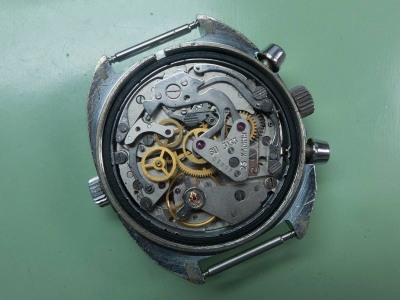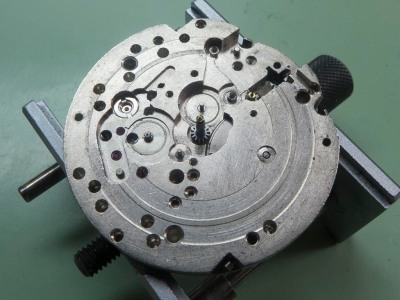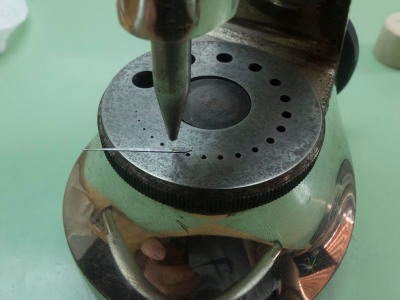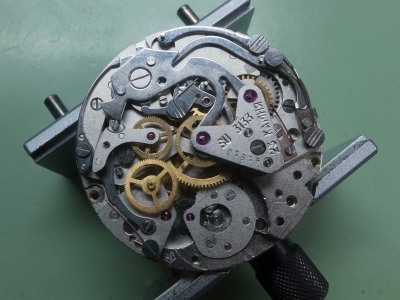The Poljot Calibre 3133 is a 23 jewel, 21,600bph, cam controlled, manual wind chronograph with a coulisse lever system. It has running seconds at the 9 o’clock sub register, minutes elapsed at 3 o’clock and a central sweep seconds counter, it also has a date a 6 o’clock. In the 1970s, the Russian Poljot factory purchased the machinery to produce the 3133 from the Swiss firm Valjoux , at that time they were disposing of the machinery that once produced their chronograph caliber 7734. Poljot then used this to produce the 31mm calibre 3133. A good proportion of the parts of the Poljot 3133 are identical to the Valjoux 7734. The main differences between the two calibres are that the Poljot has all chronograph related gears running in jewels, and the glucydur balance swings in a Poljot developed shock protection system. The balance was modified to a smaller diameter which makes the 3133 run at 21,600bph compared to the 7734’s 18.000bph. This example has an inner 12 hour bezel that can be rotated by the crown on the left of the case and it came in for attention in a non running state.
This particular Poljot has a plated base metal case with an undecorated caseback.
With the caseback removed we have a view of the completely undecorated movement, back in the 1970’s the Russians weren’t noted for doing anything that could be described as unnecessary decoration!
Apart from the movement being extremely dirty a problem was immediately spotted with the hairspring. A new balance/hairspring assembly was sourced and ordered.
We have a nice clear view of the dial now the movement has been uncased.
With the dial removed you can see the no nonsense calendar side components, the date ring numerals couldn’t look any more Russian in my opinion!.
Unfortunately when the hands were removed the chrono seconds hand parted company with its pipe, a not uncommon occurrence with Poljots. You can see the pipe left on the central pinion.
The calendar side coming apart nicely, you can see the balance top jewel which is normally located under the date ring.
And this side is completely stripped now.
Work starts on the motion work side, here the balance, chrono bridge and main cam is removed.
A shot with the all chronograph work removed.
The motion work coming apart.
Finally the movement was completely stripped ready for cleaning and inspection.
Whilst the parts were going through the Vari-Matic I turned my attention to the seconds hand which as you remember is now in two parts.
The first job was to remove the red paint.
Once it was clean the hand was staked back onto its pipe.
Then the joint was acid fluxed….
….and soldered to give it strength. Staking would be enough to secure a seconds hand on an ordinary movement, but to combat the forces encountered during a reset a chronograph seconds sweep hand needs a dab of solder.
The flux was then cleaned off and the hand spray painted red again.
The components were inspected after cleaning and the rebuild began.
The train coming together.
The main bridge and escape wheel in position.
I’d normally fit the balance at this point and get the timing and balance adjustments roughly done. However as I didn’t have the new balance yet I continued with the chronograph layer.
This was as far as I could go until the new balance arrived. The risk with this is if there is a problem with the train everything has to be removed again to gain access to it!
The watch was put away until the new balance arrived.
A few days later a package arrived from Germany with the part we needed, here it is in comparison with the old one.
The balance was adjusted then fitted and the watch was finally ticking again. I thought I was going to have to strip everything again as the amplitude wasn’t as high as I’d expected but some adjustment of the endshake sorted that out. The staff was just a little too tight between the jewel caps which reduced it.
The dial and hands were refitted.
The movement was then recased, once this is done I then adjust the depthing (mesh) of the wheels.
Once I was happy the caseback was refitted, this is a two piece affair with the back itself and a locking ring to hold it down tight.
And here she is, running once more. A handsome example of cold war horology I think!
And one with the chronograph running.




































A lovely article and very interesting to me. I have a similar model but of later vintage in stainless steel currently at the watchmaker having a service. I acquired from a Russian pilot at Germiston airport in South Africa who was delivering an old and probably clapped Antonov. He wanted drinking money and I got the Poljot for £22 almost new and was a delight to use. I just flew a Cherkee or Cessna on company business and this acquisition saved me buying a quartz because. I was also old fashion ex-RAF but thank you again for a nice expose of what is essentially my 3133.
Tony Archer
LikeLike
Splendid article and real craftsmanship!
LikeLike
Thankyou so much that took a bit of time, and you went through the process very effectively.
Just a note I personally do not like the shock spring design in some of these watches. I much prefer the Swiss .
Great images. Thankyou so much
Jon
LikeLike